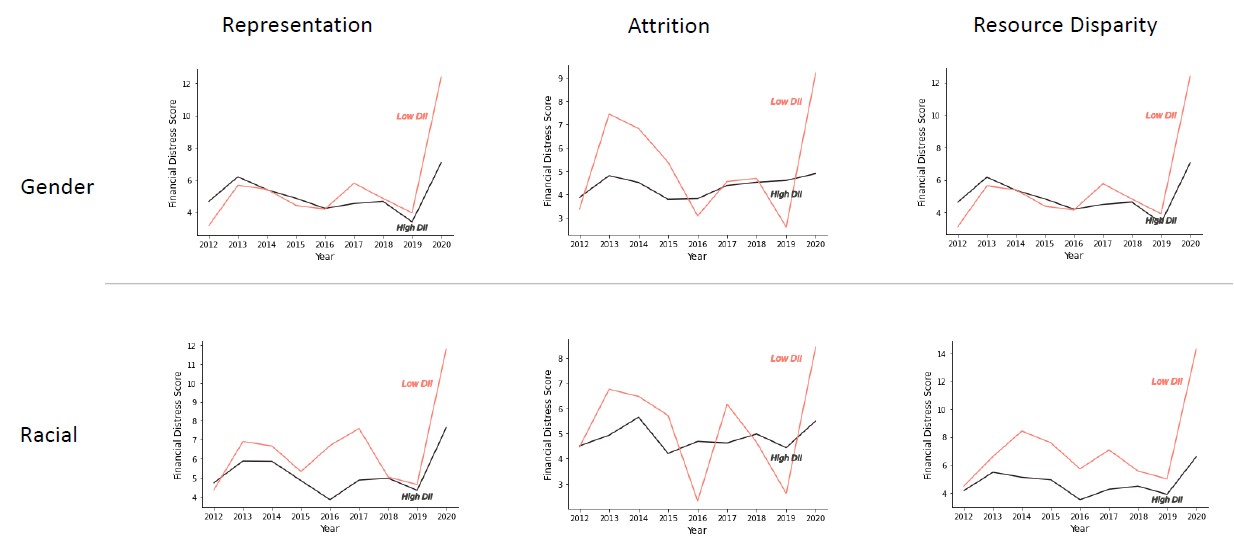Building More Resilient Organizations Through Diversity and Inclusion

From the coronavirus pandemic to the war in Ukraine, the disruptions of recent years have highlighted the importance of organizational resilience: the ability of firms to endure through, recover from, and grow following unexpected challenges and crises.
Studies have long shown that having a diverse workforce is a good business strategy. McKinsey has found that diverse companies are more likely to outperform companies with minimal diversity, and that public companies in the top quartile for diversity in executive teams offer their shareholders, on average, 53% higher return on equity than do companies in the bottom quartile.
Diversity is also an important part of building resilience. Academic research indicates that organizations with diverse workforces are richer in the collective capabilities that underlie resilience—including enhanced creativity and innovation, a wider range of perspectives and viewpoints, and a broader set of tools to apply to problems. As a result, they are better positioned to succeed in complex and fast-changing environments.
As part of our ongoing research into how a firm’s human capital affects its financial performance, Citi Ventures’ Venture Innovation Studio Data team is developing a Workforce Diversity and Inclusion Index (“the Index”). The Index quantifies and compares diversity and inclusion (D&I) outcomes across US-based public companies in order to help firms identify historical bias, provide better benchmarks for D&I efforts, and illuminate the impact of those efforts on financial performance.
Though the Index is still a work in progress, its early results suggest that firms with higher D&I scores have proven more resilient in terms of financial performance during the pandemic than firms with lower scores. They also hint that the key to long-term organizational resilience may lie in going beyond diversity to achieve true inclusion—a difference D&I advocates describe with the saying, “Diversity is being invited to the party; inclusion is being asked to dance.”
Measuring Diversity and Inclusion Multi-Dimensionally
For the purposes of our research, we define diversity as the extent to which an organization has employees of different races/ethnicities and genders. We define inclusion as the extent to which all individuals within an organization are treated fairly and have equal access to opportunities and resources.
Many studies of organizational D&I focus solely on representation of diversity in the workforce—for example, examining how many employees are people of color or what percentage of executives are women. By contrast, we employed a multidimensional analysis leveraging data from five sources, weighted by employee reviews on Glassdoor, to provide a deeper and more nuanced picture of how a firm’s D&I affects not only its financial performance but also its reputation among its own workforce.
Following the maxim that “coming together is a beginning, staying together is progress, and working together is success,” we measured the D&I outcomes of over 7,000 US-based public companies by gender and race across three categories: representation (“coming together”); attrition (“staying together”); and resource disparity (“working together”). We then merged the results into an overall index of the companies we studied, which can be broken down by industry, company size, and other factors to reveal unique insights.

The Index’s multi-dimensional methodology. Source: Citi Ventures
This differentiated approach has already yielded some compelling insights into D&I outcomes in financial services. As shown below, our results indicate that the finance industry is doing better than the other industries studied in terms of gender representation, but relatively poorly on racial representation—and is at the bottom for both race and gender attrition, meaning that women and people of color leave finance jobs at a more disproportionate rate than they do jobs in any other industry studied.
Gender Representation by Industry

Racial Representation by Industry

Gender Attrition by Industry

Racial Attrition by Industry

Source: Citi Ventures
Diversity, Inclusion, and Organizational Resilience
Drilling down to the level of individual firms presents even more intriguing insights. Though preliminary, the results of our study suggest that more diverse and inclusive firms not only tend to outperform others, but also prove more resilient during times of disruption. By examining the performance of the companies in our study during the COVID-19 pandemic, we found that firms with higher D&I scores performed better than firms with lower scores across three dimensions:
- Financial performance: Higher D&I scores across gender and race were positively associated with total revenue, and during COVID firms in the bottom quartile of D&I scores lost on average $62 million more in revenue (per firm) than those at the top.
- Investor confidence: During 2020, firms with low gender attrition scores (i.e., high gender attrition rates) declined much more in terms of stock performance than those with high scores. However, across other dimensions—particularly racial disparities in salaries—the correlation was weaker, suggesting that investors are unconvinced that a firm’s performance across those categories is a good indicator of future growth.
- Likelihood of financial distress: For all companies, the probability of becoming financially distressed (i.e., likely headed for bankruptcy) increased during the pandemic. However, companies with higher D&I scores had much lower probability than companies with lower scores—indicating that greater diversity and inclusion may be linked to financial stability, particularly during shocks like the pandemic.

Rates of financial distress among companies studied, 2012-2020.
Source: Citi Ventures
These results are consistent with other reports about corporate resilience. For example, during the 2008–09 Global Financial Crisis, banks with a higher share of women on their boards proved more more stable their peers and less likely to receive public bailouts.
Finally, our study suggests that workforce diversity efforts have a greater positive impact on resilience when they are complemented by inclusive culture. Most firms that not only hired diverse employees but also retained them and compensated them equitably enjoyed a significant revenue premium when compared to firms that have diverse workforces but less inclusive cultures.
We look forward to analyzing this data further and coming to better understand how D&I efforts can help firms of all kinds grow sustainably and equitably. Stay tuned for more!

